
Stevia is an annual herb that, when dried and ground into powder, can be used as a natural sugar replacement. This compact plant is easy to grow and has lovely green foliage that pairs well in container with other herbs and flowering annuals. This article will explain how to grow Stevia, harvest it, and preserve for use in your kitchen.
Stevia Growing Conditions
In its natural habitat, Stevia is a sub-tropical plant and can only be grown as a tender annual in most US Zones. The plant prefers warm temperatures and does best in full sun or partial shade, with at least six hours of direct sunlight per day but will benefit from mid-day shade to prevent leaves from wilting and drying out.
Stevia needs loamy, organic soil with good drainage and consistent watering but will not do well in overly-wet soils. This plant also benefits from regular fertilizing with a 10-10-10 plant food.
Space each plant at least 10” apart if planting in ground, they can be planted closer together in containers. When planting, make sure to dig a hole that is twice the size of the root ball to give the plants enough room to grow. Add compost to the bottom of the hole before planting and water thoroughly.
Stevia is generally resistant to pests and diseases, but like any plant, it can be affected by a few common problems. Aphids and whiteflies are the most common. To prevent these pests, use insecticidal soap or neem oil.
Stevia can be planted with a variety of other herbs and vegetables, including basil, mint, tomatoes, and peppers. These plants can help to deter pests and improve soil fertility. However, avoid planting stevia with plants that require heavy fertilization, such as corn or cabbage, as they can compete for nutrients and water.
How to Harvest Stevia
This plant will flower in early autumn with crisp, white blossoms which can be picked for a pretty bouquet. To promote leaf growth, though, blossoms should be snipped when buds first emerge. If flowers are allowed to mature, the plant’s leaves will take on a bitter flavor.
Stevia leaves can be picked throughout the season but leaves will be at peak sweetness in late summer and early fall. For single use, or to encourage bushier growth, pick a few leaves but leave at least 2/3 of the plant intact. If you’re planning to dry leaves, pick all of the plant’s leaves at once in early autumn. Harvest leaves in the morning to ensure peak sugar content. This plant can also be grown indoors in a sunny window but requires a large pot for root growth.
How to Use and Preserve Stevia Leaves
Freshly picked leaves can be used to sweeten hot beverages, just snip a few leaves and steep for a few minutes in hot water, tea, or coffee. Leaves can also be frozen and used in the same way throughout the year. The leaf itself can have a licorice-like aftertaste but once ground, the taste is similar to white sugar.
To use in baking and cooking, the leaves must be dried and ground into a powder. To dry leaves, use a dehydrator. Once complete dry and cool, run through a small food processor or use a mortar and pestle to crush into a finely ground powder. Store in an airtight container. Stevia powder is much sweeter (by volume) than refined white sugar! Experiment with your recipes to get the right sweetness, typically 2 tablespoons of ground stevia is equal to one cup of white sugar.
